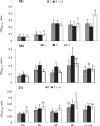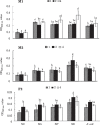Salmonella Serovars and Vaccination Effect on the Immune Responses of Male and Female Layers
- PMID: 32908400
- PMCID: PMC7477169
- DOI: 10.2141/jpsa.0150167
Salmonella Serovars and Vaccination Effect on the Immune Responses of Male and Female Layers
Abstract
Salmonella Enteritidis, S. Gallinarum and S. Pullorum are common serovars to infect poultry and cause diseases differently. The antibody production and cellular immune responses of male and female layers were evaluated before and after inoculation. Before inoculation, S. Gallinarum and S. Pullorum could survive and grow in 10% sera from 6-week-old layers, and S. Enteritidis and E. coli were completely eliminated. The weights of the male and female layers were increased the lowest by inoculation with S. Gallinarum, followed by S. Pullorum, and S. Enteritidis. Inoculation with S. Enteritidis, S. Gallinarum and S. Pullorum increased the antibody titer in the males depending on the serovars and maintained same higher antibody level in females. Furthermore, an increased anti-Salmonella IgG titer was associated with bactericidal ability and the level was reduced by serovars and complemente. Despite the vaccination and serovars, the male layers expressed more IgG2a than IgG1, indicating preferential activation of the Th1 pathway. The inoculation number affected the expression level of IFN-γ and IL-12 in the blood not in the secretion of the peripheral blood mononucleated cells (PBMCs) and more inoculations increased the expression of both cytokines. Inoculation increased more reactive oxygen species (ROS) production in polymorphonuclear (PMN) cells, not the PBMCs. ROS production was greater in cells from the males than from the females and greater in the cells treated with S. Enteritidis than S. Gallinarum and S. Pullorum. These three serovars and their vaccinations differed in sera killing and immune responses.
Keywords: IgG antibody; PBMC; PMN; Salmonella Infection; cytokine; reactive oxygen species.
2016, Japan Poultry Science Association.
Figures






Similar articles
-
An Efficient Multiplex PCR-Based Assay as a Novel Tool for Accurate Inter-Serovar Discrimination of Salmonella Enteritidis, S. Pullorum/Gallinarum and S. Dublin.Front Microbiol. 2017 Mar 16;8:420. doi: 10.3389/fmicb.2017.00420. eCollection 2017. Front Microbiol. 2017. PMID: 28360901 Free PMC article.
-
Differential cytokine expression in avian cells in response to invasion by Salmonella typhimurium, Salmonella enteritidis and Salmonella gallinarum.Microbiology (Reading). 2000 Dec;146 Pt 12:3217-3226. doi: 10.1099/00221287-146-12-3217. Microbiology (Reading). 2000. PMID: 11101679
-
Genomic comparison between Salmonella Gallinarum and Pullorum: differential pseudogene formation under common host restriction.PLoS One. 2013;8(3):e59427. doi: 10.1371/journal.pone.0059427. Epub 2013 Mar 15. PLoS One. 2013. PMID: 23555032 Free PMC article.
-
The immunobiology of avian systemic salmonellosis.Vet Immunol Immunopathol. 2009 Mar 15;128(1-3):53-9. doi: 10.1016/j.vetimm.2008.10.295. Epub 2008 Oct 17. Vet Immunol Immunopathol. 2009. PMID: 19070366 Review.
-
Phylogenetics of Salmonella enteritidis.Int J Food Microbiol. 1994 Jan;21(1-2):79-87. doi: 10.1016/0168-1605(94)90202-x. Int J Food Microbiol. 1994. PMID: 7908823 Review.
References
-
- Abbas AK, Murphy KM, Sher A. Functional diversity of helper T lymphocytes. Nature, 383: 787-793. 1996. - PubMed
-
- Anastasiadou M, Avdi M, Theodoridis A, Michailidis G. Temporal changes in the expression of avian β-defensins in the chicken vagina during sexual maturation and Salmonella infection. Veterinary Research Communications, 37: 115-122. 2013. - PubMed
-
- Anastasiadou M, Theodoridis A, Michailidis G. Effects of sexual maturation and Salmonella infection on the expression of avian β-defensin genes in the chicken testis. Veterinary Research Communications, 38: 107-113. 2014. - PubMed
-
- Barta O, Barta V, Pierson FW. Optimum conditions for the chicken lymphocyte transformation test. Avian Diseases, 3: 945-955. 1992. - PubMed

